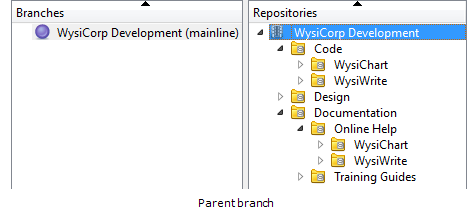Using branch templates
You can use branch templates to select specific repositories to include or exclude on a baseline, workspace, or snapshot branch. For example, you can configure a template to select multiple repositories from the parent branch to include in the child branch and exclude subrepositories you do not need.
When a template is configured for a new branch, the selected repository structure can be used for other branches created from the same parent branch later to include or exclude the same repositories. However, when a branch is created with a template, any changes made to the template for the specific branch later do not affect other branches that use the same repository structure.
Repository structure for branches that use templates
If a branch uses a template, the root repository for the branch depends on the repositories included in the template.
If only one repository is included, it becomes the root repository in the branch. This is the same structure as branches that do not use templates. For example, if the Code subrepository is selected in the WysiCorp Development mainline branch, the root repository in the child branch is WysiCorp Development/Code.
If multiple repositories at the same hierarchy level are included, a virtual root repository is created as a placeholder to show the path to the shared parent repository for all repositories included in the branch. For example, if the Code and Documentation subrepositories are included in the template for a branch created from the WysiCorp Development mainline branch, the repositories are added as subrepositories under the WysiCorp Development virtual root repository in the child branch.


Applying templates to branches
You can select specific repositories to include or exclude when creating new branches. You can also update the properties for existing branches to modify the repository structure.
- To select the specific repositories to include or exclude in a new branch, configure a new template when creating the branch. See Including and excluding repositories for new branches.
- To change the repositories included in an existing branch, update the template in the branch properties. See Modifying templates for existing branches.